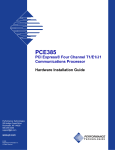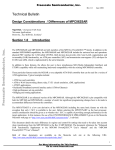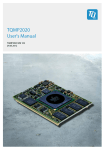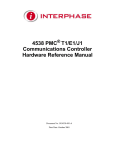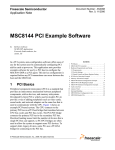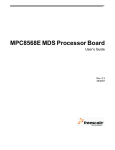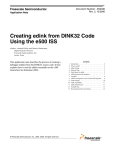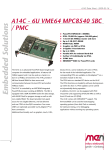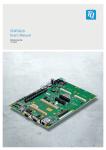Download MPC8560 and MPC8555 - Freescale Semiconductor
Transcript
Freescale Semiconductor AN2657 Rev. 1, 12/2004 Application Note Designing a Universal PowerQUICC III Board: MPC8560 and MPC8555 by Kyle Aubrey Field Applications Engineering, NCSG San Jose, CA Each processor in the PowerQUICC III family has unique features targeted to interface with a particular price point and functionality set. Because the 8555 and 8560 PowerQUICC III devices have the same footprint, it is possible to design a single board to support either of these PowerQUICC III processors. This allows a universal board to support a wide variety of applications through different component populations. For instance, a board populated one way could support lower port count and lower power using a MPC8555 at 533 MHz, but could be populated differently to support a higher port count and higher performance using the MPC8560 at 833 MHz. The result is lower fabrication costs and a wider portfolio selection. Also, because devices in the PowerQUICC III family have an e500 core and, in most cases, the same peripherals, a single software package can be maintained for the different builds of the same fabricated board. This application note is intended to assist hardware and software engineers in designing such a universal board—specifically for the MPC8560 and the MPC8555—by providing the pin, configuration, and register differences, as well as other recommendations. The following topics are addressed: © Freescale Semiconductor, Inc., 2004. All rights reserved. PRELIMINARY—SUBJECT TO CHANGE WITHOUT NOTICE 1. 2. 3. 4. 5. 6. 7. 8. 9. 10. 11. Contents Feature Differences . . . . . . . . . . . . . . . . . . . . . . . . . . . 2 Pin Differences . . . . . . . . . . . . . . . . . . . . . . . . . . . . . . 2 One-to-One CPM Pin Mapping . . . . . . . . . . . . . . . . . 9 Configuration Differences . . . . . . . . . . . . . . . . . . . . 13 Port C External Interrupts Differences . . . . . . . . . . . 16 Register Differences . . . . . . . . . . . . . . . . . . . . . . . . . 17 Processor Identification . . . . . . . . . . . . . . . . . . . . . . 19 Board Identification . . . . . . . . . . . . . . . . . . . . . . . . . 19 Disabling Peripherals . . . . . . . . . . . . . . . . . . . . . . . . 20 Universal Schematic and Layout Symbol Creation . 20 Document Revision History . . . . . . . . . . . . . . . . . . . 20 Feature Differences 1 Feature Differences The PowerQUICC III architecture of the MPC8560 and the MPC8555 integrates two processing blocks—the high-performance embedded e500 core and the communications processor module (CPM). The e500 core implements the Book E instruction set architecture and provides unprecedented levels of hardware and software debugging support. The CPM supports a wide variety of protocols. However, as shown in Table 1, the MPC8555 provides a subset of the MPC8560's CPM capabilities. Both processors offer a 256-Kbyte L2 cache, two integrated TSECs, a DDR SDRAM memory controller, a programmable interrupt controller, I2C controllers, a four-channel DMA controller, and a general-purpose I/O port. However, as Table 1 also shows, there are differences in the peripheral interfaces for PCI and RapidIO support. The MPC8555 has an integrated hardware encryption block that is not supported by the MPC8560. Table 1. MPC8560 and MPC8555 Feature Differences Functionality 2 MPC8560 MPC8555 Fast Ethernet FCC1, FCC2, FCC3 FCC1, FCC2 Gigabit Ethernet TSEC1, TSEC2 TSEC1, TSEC2 Serial interfaces TDMa1, TDMb1, TDMc1, TDMd1, TDMa2, TDMb2, TDMc2, TDMd2 TDMa2, TDMb2, TDMc2 Max logical TDM channels 256 (128 per MCC) 64 (SCC in QMC mode) ATM/UTOPIA L2 FCC1: 8/16b; FCC2: 8-bit 155 Mbps AALx, AAL1 CES, IMA, TC Layer FCC1 (8 bit), FCC2 (8 bit) 55-Mbps AALx SPI 1 1 I2C 2 2 USB 2.0 No Muxed with SCC3—Low or full speed only Dedicated and non-dedicated (SCCs/SMCs) UARTs SCC1, SCC2, SCC3, SCC4 SCC1, SCC3, SCC4, SMC1, SMC2, DUART Security No IPSec, SSL/TLS, SRTP, 802.11i, iSCSI, IKE RapidIO 8-bit No PCI Single 32-/64-bit PCI/PCI-X Single 32-/64-bit PCI or dual PCI (32 bit, 32 bit) Pin Differences Except where noted, this section lists different pin assignments from the MPC8560 to the MPC8555. 2.1 TEST_SEL Pin Changes The AH20 TEST_SEL signal on the MPC8560 should be pulled high. This signal is named TEST_SEL0 on the MPC8555 and should also be tied high with a 2–10 KΩ resistor. Designing a Universal PowerQUICC III Board: MPC8560 and MPC8555, Rev. 1 2 PRELIMINARY—SUBJECT TO CHANGE WITHOUT NOTICE Freescale Semiconductor Pin Differences The AG26 pin is a GND signal on the MPC8560, but it is TEST_SEL1 on the MPC8555 and should be tied to ground through a 100-Ω–1-KΩ resistor. For a universal board, the MPC8560 should use a 0-Ω resistor to GND for this signal to provide a population option for the 100-Ω–1-KΩ resistor for the MPC8555. These changes are summarized in Table 2. Table 2. MPC8560 to MPC8555 TEST_SEL Pin Changes Pin Assignments 2.2 MPC8560 MPC8555 AH20 TEST_SEL TEST_SEL0 2 Kbyte–10 Kbyte pull-up to OVdd 2 Kbyte–10 Kbyte pull-up to OVdd AG26 GND 0 Ω resistor to GND TEST_SEL1 100 Ω–1 KΩ resistor to GND PCI Pin Changes There are no changes if using the MPC8555 PCI1 interface as one 64-bit port or as one 32-bit port in synchronous mode. However, the MPC8555 can also be configured to have two independent PCI-32 interfaces—PCI1 and PCI2. The following sections describe changes in the pins when using the PCI2 features of the MPC8555. 2.2.1 No Connects (MPC8560) to Functional Pins (MPC8555)—No Changes if Used the Same as MPC8560 Table 3 shows the differences between no-connect (N/C) pins in the MPC8560 and pin assignments in the MPC8555 using the PCI interface in asynchronous mode. Table 3. MPC8560 No-Connects Mapping to MPC8555 PCI Signals Pin MPC8560 MPC8555 Comments AF28 N/C AVDD4 If PCI1 is disabled (DEVDISR[PCI1]=1) or is in synchronous mode, this signal can float or be tied to VDD; in asynchronous mode, this signal must be tied to VDD. When tied to VDD, the PLL power supply filter circuit (see Figure 1) should be implemented. AE28 N/C AVDD5 If PCI2 is disabled (DEVDISR[PCI2]=1) or is in synchronous mode, this signal can float or be tied to VDD; in asynchronous mode, this signal must be tied to VDD. When tied to VDD, the PLL power supply filter circuit (see Figure 1) should be implemented. AH25 N/C PCI1_CLK If PCI1 is disabled or is in synchronous mode, this signal can float or be tied to VDD; if in asynchronous mode, connect to PCI clock. AH27 N/C PCI2_CLK If PCI2 is disabled or is in synchronous mode, this signal can float or be tied to VDD; if in asynchronous mode, connect to PCI clock. Figure 1 shows the PLL power supply filter circuit for AVDD when running in asynchronous PCI mode. VDD 10 Ω AVDD4 or AVDD5 2.2 µF 2.2 µF GND Low ESL Surface Mount Capacitors Figure 1. PLL Power Supply Filter Circuit Designing a Universal PowerQUICC III Board: MPC8560 and MPC8555, Rev. 1 Freescale Semiconductor PRELIMINARY—SUBJECT TO CHANGE WITHOUT NOTICE 3 Pin Differences 2.2.2 PCI Pins (MPC8560) Changed to Dual PCI Functionality (MPC8555)—No Changes if Used the Same as MPC8560 Table 4 shows the MPC8560 PCI signals that were renamed to implement the dual PCI functionality in the MPC8555. Table 4. PCI Signal Mapping—MPC8560 to MPC8555 Pin MPC8560 MPC8555 Pin MPC8560 MPC8555 AD13 PCI_ACK64 PCI2_DEVSEL AD10 PCI_IRDY PCI1_IRDY Y14 PCI_PAR64 PCI2_PAR W11 PCI_PERR PCI1_PERR AA11 PCI_PAR PCI1_PAR AF5 PCI_REQ0 PCI1_REQ0 AC13 PCI_AD0 PCI1_AD0 AF3 PCI_REQ1 PCI1_REQ1 AB13 PCI_AD1 PCI1_AD1 AE4 PCI_REQ2 PCI1_REQ2 W12 PCI_AD10 PCI1_AD10 AG4 PCI_REQ3 PCI1_REQ3 V12 PCI_AD11 PCI1_AD11 AE5 PCI_REQ4 PCI1_REQ4 AH11 PCI_AD12 PCI1_AD12 Y11 PCI_SERR PCI1_SERR AG11 PCI_AD13 PCI1_AD13 V11 PCI_STOP PCI1_STOP AF11 PCI_AD14 PCI1_AD14 AG10 PCI_TRDY PCI1_TRDY AE11 PCI_AD15 PCI1_AD15 AF18 PCI_AD32 PCI2_AD0 AA10 PCI_AD16 PCI1_AD16 AF17 PCI_AD33 PCI2_AD1 Y10 PCI_AD17 PCI1_AD17 AD16 PCI_AD42 PCI2_AD10 W10 PCI_AD18 PCI1_AD18 AC16 PCI_AD43 PCI2_AD11 AH9 PCI_AD19 PCI1_AD19 AB16 PCI_AD44 PCI2_AD12 Y13 PCI_AD2 PCI1_AD2 W16 PCI_AD45 PCI2_AD13 AG9 PCI_AD20 PCI1_AD20 V16 PCI_AD46 PCI2_AD14 AF9 PCI_AD21 PCI1_AD21 AH15 PCI_AD47 PCI2_AD15 AE9 PCI_AD22 PCI1_AD22 AG15 PCI_AD48 PCI2_AD16 AD9 PCI_AD23 PCI1_AD23 AD15 PCI_AD49 PCI2_AD17 AG8 PCI_AD24 PCI1_AD24 AC15 PCI_AD50 PCI2_AD18 AF8 PCI_AD25 PCI1_AD25 AB15 PCI_AD51 PCI2_AD19 AC8 PCI_AD26 PCI1_AD26 AE17 PCI_AD34 PCI2_AD2 AB8 PCI_AD27 PCI1_AD27 AA15 PCI_AD52 PCI2_AD20 AH7 PCI_AD28 PCI1_AD28 Y15 PCI_AD53 PCI2_AD21 AE7 PCI_AD29 PCI1_AD29 W15 PCI_AD54 PCI2_AD22 V13 PCI_AD3 PCI1_AD3 V15 PCI_AD55 PCI2_AD23 AD7 PCI_AD30 PCI1_AD30 AH14 PCI_AD56 PCI2_AD24 AH6 PCI_AD31 PCI1_AD31 AG14 PCI_AD57 PCI2_AD25 AH12 PCI_AD4 PCI1_AD4 AF14 PCI_AD58 PCI2_AD26 AG12 PCI_AD5 PCI1_AD5 AE14 PCI_AD59 PCI2_AD27 Designing a Universal PowerQUICC III Board: MPC8560 and MPC8555, Rev. 1 4 PRELIMINARY—SUBJECT TO CHANGE WITHOUT NOTICE Freescale Semiconductor Pin Differences Table 4. PCI Signal Mapping—MPC8560 to MPC8555 (continued) 2.3 Pin MPC8560 MPC8555 Pin MPC8560 MPC8555 AE12 PCI_AD6 PCI1_AD6 AD14 PCI_AD60 PCI2_AD28 AD12 PCI_AD7 PCI1_AD7 AC14 PCI_AD61 PCI2_AD29 AB12 PCI_AD8 PCI1_AD8 AB17 PCI_AD35 PCI2_AD3 Y12 PCI_AD9 PCI1_AD9 AB14 PCI_AD62 PCI2_AD30 AC12 PCI_C/BE0 PCI1_C/BE0 AA14 PCI_AD63 PCI2_AD31 AD11 PCI_C/BE1 PCI1_C/BE1 AA17 PCI_AD36 PCI2_AD4 AB10 PCI_C/BE2 PCI1_C/BE2 Y17 PCI_AD37 PCI2_AD5 AH8 PCI_C/BE3 PCI1_C/BE3 W17 PCI_AD38 PCI2_AD6 AH10 PCI_DEVSEL PCI1_DEVSEL V17 PCI_AD39 PCI2_AD7 AC10 PCI_FRAME PCI1_FRAME AF16 PCI_AD40 PCI2_AD8 AE6 PCI_GNT0 PCI1_GNT0 AE16 PCI_AD41 PCI2_AD9 AG5 PCI_GNT1 PCI1_GNT1 W14 PCI_C/BE4 PCI2_C/BE0 AH5 PCI_GNT2 PCI1_GNT2 V14 PCI_C/BE5 PCI2_C/BE1 AF6 PCI_GNT3 PCI1_GNT3 AH13 PCI_C/BE6 PCI2_C/BE2 AG6 PCI_GNT4 PCI1_GNT4 AG13 PCI_C/BE7 PCI2_C/BE3 AA9 PCI_IDSEL PCI1_IDSEL AE13 PCI_REQ64 PCI2_FRAME RapidIO Pins (MPC8560) Changed to Second 32-Bit PCI Interface (MPC8555) Table 5 shows which MPC8560 RapidIO pins were reassigned to implement the second 32-bit PCI interface in the MPC8555. If the RapidIO interface is not used on the MPC8560, DEVDISR[RIO] should be set to disable the logic. Table 5. MPC8560 RapidIO Pin Mapping to MPC8555 PCI Signals Pin MPC8560 MPC8555 AC18 RIO_TD1 PCI2_GNT0 AD18 RIO_TD0 PCI2_GNT1 AE18 RIO_TD0 PCI2_GNT2 AE19 RIO_TD1 PCI2_GNT3 AD19 RIO_TD2 PCI2_GNT4 AC22 RIO_TD6 PCI2_IDSEL AD20 RIO_TD3 PCI2_IRDY AC20 RIO_TCLK PCI2_PERR AD21 RIO_TD4 PCI2_REQ0 AE21 RIO_TCLK PCI2_REQ1 Designing a Universal PowerQUICC III Board: MPC8560 and MPC8555, Rev. 1 Freescale Semiconductor PRELIMINARY—SUBJECT TO CHANGE WITHOUT NOTICE 5 Pin Differences Table 5. MPC8560 RapidIO Pin Mapping to MPC8555 PCI Signals (continued) 2.4 Pin MPC8560 MPC8555 AD22 RIO_TD5 PCI2_REQ2 AE22 RIO_TD5 PCI2_REQ3 AC21 RIO_TD4 PCI2_STOP AE20 RIO_TD3 PCI2_SERR AC23 RIO_TD7 PCI2_REQ 4 AC19 RIO_TD2 PCI2_TRDY CPM Pins (MPC8560) Changed to DUART Pins (MPC8555) Table 6 shows which MPC8560 CPM pins were reassigned to implement the DUART interface in the MPC8555. For reference, the last column of the table shows the pin assignments for the equivalent UART signals on the MPC8560 using the SCCs. However, it should be noted that the CPM SCC UARTs programming model is different than the DUART block of the MPC8555. For recommended CPM pin mux configurations for both the MPC8560 and MPC8555, see Section 3, “One-to-One CPM Pin Mapping.” Table 6. MPC8560 CPM Pin Mapping to MPC8555 DUART Signals 2.5 Pin MPC8560 CPM Port Name MPC8555 DUART Name Equivalent SCC UART Signal (Pin Assignment) Y1 pd4 UART_RTS0 pd29/SCC1_RTS (AD6) Y2 pd5 UART_CTS0 pc15/SCC1_CTS (U9) P11 pb14 UART_SIN0 pd31/SCC1_RXD (AE2) N6 pb8/SCC3_TXD UART_SOUT0 pd30/SCC1_TXD (AE3) AD1 pd26/SCC2_RTS UART_RTS1 — Y3 pd6 UART_CTS1 pc13/SCC2_CTS (U7) AD5 pd28/SCC2_RXD UART_SIN1 — AD2 pd27/SCC2_TXD UART_SOUT1 — CPM Pins (MPC8560) Changed to No-Connect (MPC8555) Table 7 shows which MPC8560 CPM pins are reassigned as no-connects (N/C) on the MPC8555. Designing a Universal PowerQUICC III Board: MPC8560 and MPC8555, Rev. 1 6 PRELIMINARY—SUBJECT TO CHANGE WITHOUT NOTICE Freescale Semiconductor Pin Differences Table 7. MPC8560 CPM Pin Mapping to No-Connects on MPC8555 Port Pin MPC8560 MPC8555 J6 pa7 N/C J5 pa6 N/C J4 pa5 N/C J3 pa4 N/C J2 pa3 N/C J1 pa2 N/C H2 pa1 N/C H1 pa0 N/C P9 pb16 N/C P10 pb15 N/C N11 pb13 N/C N10 pb12 N/C N9 pb11 N/C N8 pb10 N/C N7 pb9 N/C N5 pb7 N/C N4 pb6 N/C N1 pb5 N/C M1 pb4 N/C P8 pb1 N/C Y9 pc31 N/C W9 pc30 N/C R11 pc3 N/C R10 pc2 N/C AA3 pd13 N/C AA4 pd12 N/C AA7 pd11 N/C AA8 pd10 N/C Y6 pd9 N/C Y5 pd8 N/C A B C D Designing a Universal PowerQUICC III Board: MPC8560 and MPC8555, Rev. 1 Freescale Semiconductor PRELIMINARY—SUBJECT TO CHANGE WITHOUT NOTICE 7 Pin Differences 2.6 MPC8560 RapidIO Pins Changed to No-Connect (MPC8555) Table 8 shows which MPC8560 RapidIO pins are reassigned as no-connects on the MPC8555. Note that if the MPC8560’s RapidIO port is not used, it should be disabled with software by setting DEVDISR[RIO]. If disabled, all RapidIO signals can be seen as N/Cs and left unterminated, saving valuable board space. Table 8. MPC8560 RapidIO Pin Mapping to No-Connects on MPC8555 Pin MPC8560 MPC8555 AF25 RIO_TX_CLK_IN N/C AF24 RIO_TX_CLK_IN N/C AE25 RIO_TFRAME N/C AE24 RIO_TFRAME N/C AE23 RIO_TD6 N/C AD23 RIO_TD7 N/C AE26 RIO_RFRAME N/C AE27 RIO_RFRAME N/C AD24 RIO_RD7 N/C AC24 RIO_RD6 N/C AB24 RIO_RD5 N/C AA24 RIO_RD4 N/C W24 RIO_RD3 N/C V24 RIO_RD2 N/C U24 RIO_RD1 N/C T24 RIO_RD0 N/C AD25 RIO_RD7 N/C AC25 RIO_RD6 N/C AB25 RIO_RD5 N/C AA25 RIO_RD4 N/C W25 RIO_RD3 N/C V25 RIO_RD2 N/C U25 RIO_RD1 N/C T25 RIO_RD0 N/C Y24 RIO_RCLK N/C Y25 RIO_RCLK N/C Designing a Universal PowerQUICC III Board: MPC8560 and MPC8555, Rev. 1 8 PRELIMINARY—SUBJECT TO CHANGE WITHOUT NOTICE Freescale Semiconductor One-to-One CPM Pin Mapping 3 One-to-One CPM Pin Mapping Because some functionality and port pins have been removed from the MPC8555’s CPM, care should be taken in selecting which pins to use to maintain functionality on the universal PowerQUICC III board when moving from the MPC8560 to the MPC8555. This section describes which dedicated controller signals and serial interfaces are identical for the MPC8560 and MPC8555. 3.1 FCC Pin Muxing The logic for FCC3 and the 16-bit UTOPIA interface for FCC1 is not available with the MPC8555 CPM. Additionally, the 8-bit UTOPIA interface pins on the FCC2 do not map one-to-one between the MPC8560 and MPC8555, so it is recommended to only use FCC1 for the UTOPIA interface when designing a universal PowerQUICC III board to support ATM. In summary, the interfaces that map one-to-one for FCC1 for both the MPC8560 and MPC8555 are 8-bit UTOPIA for ATM, Fast Ethernet via RMII or MII, HDLC, and Transparent, as shown in Table 9. Table 9. Recommended FCC1 Pins for Footprint Compatibility FCC1 NMSI Port Pins UTOPIA L2 8-Bit MII RMII HDLC/ Transparent pa25 TxD0 — — — pa24 TxD1 — — — pa23 TxD2 — — — pa22 TxD3 — — — pa21 TxD4 TxD3 — TxD3 pa20 TxD5 TxD2 — TxD2 pa19 TxD6 TxD1 TxD1 TxD1 pa18 TxD7 TxD0 TxD0 TxD0 pa10 RxD0 — — — pa11 RxD1 — — — pa12 RxD2 — — — pa13 RxD3 — — — pa14 RxD4 RxD3 — RxD3 pa15 RxD5 RxD2 — RxD2 pa16 RxD6 RxD1 RxD1 RxD1 pa17 RxD7 RxD0 RxD0 RxD0 pc15 TxADDR0 — — — pc13 TxADDR1 — — — pc7 TxADDR2 — — CTS pd7 TxADDR3 — — — pd19 TxADDR4 — — — Designing a Universal PowerQUICC III Board: MPC8560 and MPC8555, Rev. 1 Freescale Semiconductor PRELIMINARY—SUBJECT TO CHANGE WITHOUT NOTICE 9 One-to-One CPM Pin Mapping Table 9. Recommended FCC1 Pins for Footprint Compatibility (continued) FCC1 NMSI Port Pins UTOPIA L2 8-Bit MII RMII HDLC/ Transparent pc14 RxADDR0 — — — pc12 RxADDR1 — — — pc6 RxADDR2 — — CD pd29 RxADDR3 — — — pd18 RxADDR4 — — — pa31 TxEnb COL — — pa28 RxEnb TX_EN TX_EN — pa30 TxClav CRS — RTS pa26 RxClav RX_ER RX_ER — pa29 TxSOC TX_ER — — pa27 RxSOC RX_DV CRS_DV — pd16, pc22 TxPrty — — — pd17, pc27 RxPrty — — — The interfaces for FCC2 are Fast Ethernet using MII or RMII, HDLC, and Transparent, as shown in Table 10. Table 10. Recommended FCC2 Pins for Footprint Compatibility FCC2 NMSI Port Pins MII RMII HDLC/ Transparent pb27 COL — — pb26 CRS — — pb25 TxD3 — TxD3 pb24 TxD2 — TxD2 pb23 TxD1 TxD1 TxD1 pb22 TxD0 TxD0 TxD0 pb18 RxD3 — RxD3 pb19 RxD2 — RxD2 pb20 RxD1 RxD1 RxD1 pb21 RxD0 RxD0 RxD0 pb29 TX_EN TX_EN — pb30 RX_DV CRS_DV — pb31 TX_ER — — pc4 — — CD Designing a Universal PowerQUICC III Board: MPC8560 and MPC8555, Rev. 1 10 PRELIMINARY—SUBJECT TO CHANGE WITHOUT NOTICE Freescale Semiconductor One-to-One CPM Pin Mapping Table 10. Recommended FCC2 Pins for Footprint Compatibility (continued) 3.2 FCC2 NMSI Port Pins MII RMII HDLC/ Transparent pb28 RX_ER RX_ER RTS pc5 — — CTS SCC Pin Muxing The logic for SCC2 is not available with the MPC8555 CPM. The pins for SCC1, SCC3, and SCC4 that map one-to-one for the MPC8560 and MPC8555 are shown in Table 11. Table 11. Recommended SCCx Pins for Footprint Compatibility SCCx NMSI Port Pins UART/HDLC/Transparent SCC1 pb28, pd30 TxD pd31 RxD pd29 RTS pc29, pc15 CTS pc14 CD pd24 TxD pd25 RxD pd23 RTS pc11, pc8 CTS pc10 CD pd21 TxD pd22 RxD pd20 RTS pc9 CTS pc8 CD SCC3 SCC4 3.3 TDM Pin Muxing MPC8560 and MPC8555 support multiple serial interfaces for dedicated TDM streams. The MPC8560 supports a total of eight possible serial interfaces: TDMa1–TDMd1 and TDMa2–TDMd2, whereas the MPC8555 supports only three: TDMa2, TDMb2, and TDMc2. For complete one-to-one mapping, only TDMa2 can be used. If L1RQ and L1CLKO are not required, TDMc2 (MPC8560)/TDMb2 (MPC8555) can be used. However, it should be noted that SIRAM register differences apply. Lastly, TDMc2 on the MPC8555 does not map to another TDM port on the MPC8560. The pins for TDMa2 that map one-to-one for the MPC8560 and MPC8555 are shown in Table 12. Designing a Universal PowerQUICC III Board: MPC8560 and MPC8555, Rev. 1 Freescale Semiconductor PRELIMINARY—SUBJECT TO CHANGE WITHOUT NOTICE 11 One-to-One CPM Pin Mapping Table 12. Recommended TDMa2 Pins for Footprint Compatibility Serial Interface Port Pins TDMa2 Signals pd22 L1TXD pd21 L1RXD pc9 L1TSYNC pd20 L1RSYNC pc1 L1RQ pc0 L1CLKO The pins for TDMc2 (MPC8560) and TDMb2 (MPC8555) that map one-to-one are shown in Table 13. Table 13. Recommended TDMc2 (MPC8560)/TDMb2 (MPC8555) Pins for Footprint Compatibility 3.4 Serial Interface Port Pins TDMc2(8560)/TDMb2(8555) Signals pb27 L1TXD pb26 L1RXD pb25 L1TSYNC pb24 L1RSYNC SPI Pin Muxing The pins for SPI that map one-to-one are shown in Table 14. Table 14. Recommended SPI Pins for Footprint Compatibility 3.5 Port Pins SPI Signals pd19 SPISEL pd18 SPICLK pd17 SPIMOSI pd16 SPIMISO CPM I2C Pin Muxing The pins for I2C that map one-to-one are shown in Table 15. Table 15. Recommended I2C Pins for Footprint Compatibility Port Pins SPI Signals pd15 I2CSDA pd14 I2CSCL Designing a Universal PowerQUICC III Board: MPC8560 and MPC8555, Rev. 1 12 PRELIMINARY—SUBJECT TO CHANGE WITHOUT NOTICE Freescale Semiconductor Configuration Differences 3.5.1 Banks of Clocks Mapping The CPM provides for multiple clock sources into the PowerQUICC III device. The MPC8560 provides 20 possible sources (CLK1–CLK20) whereas the MPC8555 provides 14 possible clock sources (CLK3–CLK16). When using one-to-one mapped controllers with NMSI pin muxing, available clocks to each controller are the same. When using the dedicated serial interfaces for TDM, there are exceptions to the available clock sources, as shown in Table 16. Table 16. CLK Mapping for MPC8560 and MPC8555 MPC8555 Clock MPC8560 Clock Available clock sources TDMa2 Rx TDMa2 Rx CLK5, CLK13 TDMa2 Tx TDMa2 Tx CLK6, CLK14 TDMb2 Rx TDMc2 Rx CLK3 CLK17 is not available on the MPC8555 TDMb2 Tx TDMc2 Tx CLK4 CLK18 is not available on the MPC8555 TDMc2 Rx — CLK5, CLK13 TDMc2 Tx — CLK6, CLK14 Notes Available clocks for TDMa2 are identical Because the MPC8555 TDMc2 does not map to another TDM interface on MPC8560, care should be taken when using TDMc2 on the MPC8555. Because TDMc2 of the MPC8560 maps directly to the TDMb2 of the MPC8555 as discussed in Section 3.3, “TDM Pin Muxing,” the clock pins also map directly to each TDM interface as shown in Table 16. 4 Configuration Differences Most POR configuration pins are the same between the MPC8560 and MPC8555; however there are a few exceptions. Table 17 shows these exceptions in addition to all possible configurations. These differences are due mostly to the differences in available peripheral blocks or relocation of configuration signals. Table 17. POR Configuration Differences Source CCB Clock: SYSCLK Ratio Configuration Signals LA[28:31] Reset Configuration Name cfg_sys_pll[0:3] Value (Binary) Meaning 0010 2:1 0011 3:1 0100 4:1 0101 5:1 0110 6:1 1000 8:1 1001 9:1 1010 10:1 1100 12:1 0000 16:1 Designing a Universal PowerQUICC III Board: MPC8560 and MPC8555, Rev. 1 Freescale Semiconductor PRELIMINARY—SUBJECT TO CHANGE WITHOUT NOTICE 13 Configuration Differences Table 17. POR Configuration Differences (continued) Source e500 Core: CCB Clock Ratio Boot ROM Location Configuration Signals LALE, LGPL2 TSEC1_TXD[6:4] (MPC8560) Reset Configuration Name cfg_core_pll[0:1] cfg_rom_loc[0:2] LGPL0, LGPL1, LWE[3] (MPC8555) Host/Agent LWE[2:3] (MPC8560) LWE[2] (MPC8555) CPU Boot Boot Sequencer TSEC Width TSEC1 Protocol LA27 cfg_host_agt[0:1] cfg_host_agt cfg_cpu_boot LGPL3, LGPL5 EC_MDC TSEC1_TXD7 (MPC8560) cfg_boot_seq[0:1] cfg_tsec_reduce cfg_tsec1 TSEC2_TXD3 (MPC8555) TSEC2 Protocol TSEC2_TXD7 (MPC8560) TSEC2_TXD2 (MPC8555) cfg_tsec2 Value (Binary) Meaning 00 2:1 01 2.5:1 10 3:1 11 3.5:1 000 PCI/PCI-X (MPC8560) PCI 1 (MPC8555) 001 DDR SDRAM 010 PCI 2 (MPC8555) 011 RapidIO (MPC8560) 101 Local bus GPCM—8-bit ROM 110 Local bus GPCM—16-bit ROM 111 Local bus GPCM—32-bit ROM (default) 00 PCI/PCI-X & RapidIO agent 01 RapidIO agent 10 PCI/PCI-X agent 11 Host for all (default) 0 PCI 1 Agent (MPC8555) 1 Host for all (default) 0 CPU boot hold off mode 1 Boot without waiting (default) 01 Normal I2C addressing 10 Extended I2C addressing 11 Boot sequencer disabled (default) 0 Reduced mode: RTBI or RGMII 1 Standard mode: TBI or GMII (default) 0 TSEC1: GMII or RGMII 1 TSEC1: TBI or RTBI (default) 0 TSEC2: GMII or RGMII 1 TSEC2: TBI or RTBI (default) Designing a Universal PowerQUICC III Board: MPC8560 and MPC8555, Rev. 1 14 PRELIMINARY—SUBJECT TO CHANGE WITHOUT NOTICE Freescale Semiconductor Configuration Differences Table 17. POR Configuration Differences (continued) Source Configuration Signals RapidIO LGPL0, LGPL1 (MPC8560) Transmit Clock Source RapidIO Device ID Reset Configuration Name cfg_no_clk[0:1] Value (Binary) Meaning 01 RapidIO RxCLK is source of TxCLK 10 RapidIO TxCLK inputs are source of TxCLK 11 CCB clock is source of TxCLK (default) TSEC2_TXD2 (MPC8560) cfg_dev_ID5 x Device ID for RapidIO hosts TSEC2_TXD3 (MPC8560) cfg_dev_ID6 x Device ID for RapidIO hosts TSEC2_TXD4 (MPC8560) cfg_dev_ID7 x Device ID for RapidIO hosts PCI 1 Clock Select TSEC2_TXD1 (MPC8555) cfg_pci1_clk 0 Async mode, PCI1_CLK used 1 Sync mode, SYSCLK used (default) PCI 2 Clock Select TSEC2_TXD0 (MPC8555) 0 Async mode, PCI2_CLK used 1 Sync mode, SYSCLK used (default) PCI Width PCI_REQ64 (MPC8560) 0 PCI/PCI-X operates in 64-bit mode (MPC8560) PCI operates in 64-bit mode (MPC8555) 1 PCI/PCI-X operates in 32-bit mode (MPC8560) (default) PCI operates as two 32-bit interfaces (MPC8555) (default) cfg_pci_impd (MPC8560) cfg_pci1_impd (MPC8555) 0 25 Ω I/O drivers are used on the PCI interface 1 42 Ω I/O drivers are used on the PCI interface (default) cfg_pci2_impd 0 25 Ω I/O drivers are used on the PCI 2 interface 1 42 Ω I/O drivers are used on the PCI 2 interface (default) cfg_pci2_clk cfg_pci_width PCI1_REQ64/PCI2_FRAME (MPC8555) PCI I/O Impedance PCI_GNT1 (MPC8560) PCI1_GNT1 (MPC8555) PCI2_GNT1 (MPC8555) PCI Arbiter PCI Debug PCI_GNT2 (MPC8560) PCI1_GNT2 (MPC8555) cfg_pci_arbiter (MPC8560) cfg_pci1_arbiter (MPC8555) 0 PCI arbiter disabled 1 PCI arbiter enabled (default) PCI2_GNT2 (MPC8555) cfg_pci1_arbiter 0 PCI 2 arbiter disabled 1 PCI 2 arbiter enabled (default) 0 PCI debug is enabled 1 Normal PCI mode (default) PCI_GNT3 (MPC8560) PCI1_GNT3 (MPC8555) cfg_pci_debug Designing a Universal PowerQUICC III Board: MPC8560 and MPC8555, Rev. 1 Freescale Semiconductor PRELIMINARY—SUBJECT TO CHANGE WITHOUT NOTICE 15 Port C External Interrupts Differences Table 17. POR Configuration Differences (continued) Source PCI Debug Configuration Signals PCI_GNT3 (MPC8560) Reset Configuration Name cfg_pci_debug PCI1_GNT3 (MPC8555) PCI-X PCI_GNT4 (MPC8560) Memory Debug MSRCID0 DDR Debug MSRCID1 PCI Output Hold LWE[0:1] (MPC8560) PCI1_GNT4 (MPC8555) PCI2_GNT4 (MPC8555) Local Bus Output Hold TSEC2_TXD[6:5] (MPC8560) cfg_pci_mode cfg_mem_debug cfg_ddr_debug cfg_pci_hold[0:1] cfg_pci1_hold cfg_pci2_hold cfg_lb_hold[0:1] LWE[0:1] (MPC8555) GeneralLAD[0:31] Purpose POR 5 cfg_gpporcr Value (Binary) Meaning 0 PCI debug is enabled 1 Normal PCI mode (default) 0 PCI-X mode 1 PCI mode (default) 0 LBC debug info driven 1 DDR debug info driven (default) 0 Debug info driven on ECC pins 1 Debug info is not driven on ECC pins (default) 11 PCI: 2 buffer delays PCI-X: 0 buffer delay (default) 10 PCI: 3 buffer delays PCI-X: 1 buffer delay 01 PCI: 0 buffer delay PCI-X: 2 buffer delays 00 PCI: 1 buffer delay PCI-X: 3 buffer delays 1 PCI1: 2 buffers delays (default) 0 PCI1: 0 buffer delay 1 PCI2: 2 buffers delays (default) 0 PCI2: 0 buffer delays 11 One buffer delay (default) 10 Two buffer delays 01 Three buffer delays 00 Zero buffer delays xx Vector placed in GPPORCR Port C External Interrupts Differences The MPC8560 has 16 potential external interrupts through the use of the CPM’s Port C. Since PC2 and PC3 are N/Cs on the MPC8555, two potential interrupts had to be moved to another location in Port C: PC23 and PC29. However, it should be noted that the priority levels of PC23 and 29 are higher than the rest of the external interrupts and not the same as PC2 and PC3. The available interrupts and their priority levels are shown in Table 15. To maintain interrupt priorities and pin compatibility, PC2, PC3, PC23, and PC29 should not be used for interrupts on a universal PowerQUICC III board. Designing a Universal PowerQUICC III Board: MPC8560 and MPC8555, Rev. 1 16 PRELIMINARY—SUBJECT TO CHANGE WITHOUT NOTICE Freescale Semiconductor Register Differences Table 18. Port C External Interrupt Differences 6 CPM Priority Level MPC8560 Interrupts MPC8555 Interrupts 18 (Highest) PC29 PC15 20 PC23 PC14 22 PC15 PC13 26 PC14 PC12 27 PC13 PC11 30 PC12 PC10 35 PC11 PC9 36 PC10 PC8 40 PC9 PC7 41 PC8 PC6 42 PC7 PC5 45 PC6 PC4 48 PC5 PC3 49 PC4 PC2 53 PC1 PC1 54 (Lowest) PC0 PC0 Register Differences Due to peripheral differences between the MPC8560 and MPC8555, certain register differences need to be addressed. For instance, the MPC8555 has added registers for the second PCI port but has removed the RapidIO registers. This section discusses other associated register and field differences between the two devices. Additionally, note that any reserved field or area of memory should not be programmed; doing so could cause unwanted behavior of the device. In most cases, reserved fields should be cleared when programming registers, however this may not always be the case. The user should refer to the user manual for more information on proper programming of reserved fields. This section only covers the differences; common registers are not shown. 6.1 MPC8560-Only Registers Table 19 indicates which registers are available only on the MPC8560, for those registers that are only available on the MPC8555, refer to Table 20. Please note that there may be some fields in matching registers that are only available for the MPC8560 or vice versa. The user should refer to the user manuals of both devices for a comparison of these registers. Designing a Universal PowerQUICC III Board: MPC8560 and MPC8555, Rev. 1 Freescale Semiconductor PRELIMINARY—SUBJECT TO CHANGE WITHOUT NOTICE 17 Register Differences Table 19. MPC8560-Only CCSR Registers Register 1 Offset 0x8_0000–0x8_3FFF DPRAM1–Dual Port RAM (16k) 0x8_8000–0x8_BFFF DPRAM2–Dual Port RAM (16k) 0x9_1340–0x9_137F, 0x9_13D0–0x9_13FF FCC3 Registers 0x9_1400–0x9_1414 TC layer 1 registers 0x9_1420–0x9_1434 TC layer 2 registers 0x9_1440–0x9_1454 TC layer 3 registers 0x9_1460–0x9_1474 TC layer 4 registers 0x9_1480–0x9_1494 TC layer 5 registers 0x9_14A0–0x9_14B4 TC layer 6 registers 0x9_14C0–0x9_14D4 TC layer 7 registers 0x9_14E0–0x9_14F4 TC layer 8 registers 0x9_1500–0x9_1503 TC layer–general registers 0x9_1A20–0x9_1A3F SCC2 registers 0x9_1B00 CMXSI1CR–CPM Mux SI1 clock route register 0x9_1B20–0x9_1B2F SI1 registers 0x9_1B30–0x9_1B3F MCC1 registers 0x9_1B46 SI2DMR–SI2 TDMD2 mode register 0x9_1B50–0x9_1FFF MCC2 registers 0x9_2000–0x9_27FF SI1 RAM 0xA_0000–0xA_7FFF IRAM–instruction RAM (32k) 0xC_0000–0x RapidIO registers 1 6.2 See the MPC8560 Reference Manual for a full description of all associated registers. MPC8555-Only Registers Table 20 indicates which registers are only available only on the MPC8555; for those registers which are only available on the MPC8560, refer to Table 19. Table 20. MPC8555-Only CCSR Registers Register 1 Offset 0x0_4500–0x 0_4511 UART0 registers 0x0_4600–0x0_4611 UART1 registers 0x0_9000–0x0_9FFC PCI2 registers 0x3_0000–0x3_CFFF Security engine registers Designing a Universal PowerQUICC III Board: MPC8560 and MPC8555, Rev. 1 18 PRELIMINARY—SUBJECT TO CHANGE WITHOUT NOTICE Freescale Semiconductor Processor Identification Table 20. MPC8555-Only CCSR Registers (continued) Register 1 Offset 0x8_0000–0x8_1FFF DPRAM1–dual port RAM (8 Kbytes) 0x8_8000–0x8_9FFF DPRAM2–dual port RAM (8 Kbytes) 0x9_1A82–0x9_1A8F SMC1 registers 0x9_1A92–0x9_1A9F SMC2 registers 0x9_1B0C CMXSMR–CPM Mux SMC clock route register 0x9_1B60–0x9_1FFF USB registers 0xA_0000–0xA_0FFF IRAM–instruction RAM (4 Kbytes) 1 7 See the MPC8555 Reference Manual for a full description of all associated registers. Processor Identification The revision codes in the processor version register (PVR) and the system version register (SVR) map to a particular revision level marked on the device, as shown in Table 21. These registers can be accessed as SPRs through the e500 core or as memory-mapped registers. As such, a single software package can be created based on these registers that supports not only multiple silicon revisions of the same PowerQUICC III processor by addressing certain errata workarounds for a particular revision, but that also supports different members of the PowerQUICC III family. The PVR identifies the version of the processor and the implementation of the version. Different version numbers indicate major differences between processors, such as which optional facilities and instructions are supported. Different revision numbers indicate minor differences between processors having the same version number, such as clock rate and engineering change level. The SVR identifies the version of the system logic and the implementation of the version. Different version numbers indicate major differences in system logic. Different revision numbers indicate less significant changes in system logic to address system logic errata or enhance certain features. Table 21. Revision Level to Device Marking Cross-Reference Silicon Revision 8 e500 Core Revision Device Marking Processor Version Register (PVR) System Version Register (SVR) PCI DevID MPC8560 Rev. 1 1.0 PPC8560PXxxxLA 0x8020_0010 0x8070_0010 0x09 MPC8560 Rev. 2 2.0 MPC8560PXxxxLB 0x8020_0020 0x8070_0020 0x09 MPC8555 Rev. 1 2.0 MPC8555PXxxxLA 0x8020_0010 0x8079_0010 0x0A Board Identification It is important to be able to identify the version of the board based on how it is populated. To do this, the version of the board can be indicated through the use of the value found in the general-purpose POR configuration register (GPPORCR). This value is sampled from the local bus address/data signals, LAD[0:31], during POR. Software can use this value to inform the operating system about initial system configuration allowing software to not only disable those features not used on the processor, but to also initialize all of the populated devices on that version of the board using the same software package. Designing a Universal PowerQUICC III Board: MPC8560 and MPC8555, Rev. 1 Freescale Semiconductor PRELIMINARY—SUBJECT TO CHANGE WITHOUT NOTICE 19 Disabling Peripherals Additionally, the POR configuration values of all device parameters sampled from pins at reset, such as PLL multiplication values, are available through memory-mapped registers in the global utilities block. 9 Disabling Peripherals The device disable register (DEVDISR) contains disable bits for various PowerQUICC III functional blocks. The register is different between the MPC8560 and MPC8555 because available peripherals differ. All functional blocks are enabled after reset; unneeded blocks can be disabled to reduce power consumption or allow their signals to be used as general-purpose I/O signals. The disablement of these blocks can be based on either the system version and/or the board version as mentioned in the previous two sections. Please note that blocks disabled by DEVDISR must not be re-enabled without a hard reset. 10 Universal Schematic and Layout Symbol Creation The MPC8560 and MPC8555 have identical footprints, so the same layout symbol may be used for both. It is recommended that unified schematic symbols be created for both the MPC8560 and MPC8555 if both processors are going to be used for the same fabricated board. If this is not feasible, the creation of two identical symbol blocks with all NCs and Reserved pins shown should be created. Additionally, all signals listed in Section 2, “Pin Differences,” should maintain the identical pin placement for creating visual compatibility in the schematic. To obtain the schematic symbols for both the MPC8560 and MPC8555, contact your local Motorola salesperson or field applications engineer (FAE). Symbols are available in Mentor Graphics®-compatible and EDIF formats. 11 Document Revision History Table 22 provides a revision history for this application note. Table 22. Revision History Table Revision Date Substantive Change(s) 1 12/2004 Updated document template. In Table 5, changed pin assignments to PCI2_STOP = AC21and PCI2_REQ4 = AC23 0 4/2004 Initial release Designing a Universal PowerQUICC III Board: MPC8560 and MPC8555, Rev. 1 20 PRELIMINARY—SUBJECT TO CHANGE WITHOUT NOTICE Freescale Semiconductor Document Revision History THIS PAGE INTENTIONALLY LEFT BLANK Designing a Universal PowerQUICC III Board: MPC8560 and MPC8555, Rev. 1 Freescale Semiconductor PRELIMINARY—SUBJECT TO CHANGE WITHOUT NOTICE 21 Document Revision History THIS PAGE INTENTIONALLY LEFT BLANK Designing a Universal PowerQUICC III Board: MPC8560 and MPC8555, Rev. 1 22 PRELIMINARY—SUBJECT TO CHANGE WITHOUT NOTICE Freescale Semiconductor Document Revision History THIS PAGE INTENTIONALLY LEFT BLANK Designing a Universal PowerQUICC III Board: MPC8560 and MPC8555, Rev. 1 Freescale Semiconductor PRELIMINARY—SUBJECT TO CHANGE WITHOUT NOTICE 23 How to Reach Us: Home Page: www.freescale.com email: [email protected] USA/Europe or Locations Not Listed: Freescale Semiconductor Technical Information Center, CH370 1300 N. Alma School Road Chandler, Arizona 85224 (800) 521-6274 480-768-2130 [email protected] Information in this document is provided solely to enable system and software implementers to use Freescale Semiconductor products. There are no express or implied copyright licenses Europe, Middle East, and Africa: Freescale Halbleiter Deutschland GmbH Technical Information Center Schatzbogen 7 81829 Muenchen, Germany +44 1296 380 456 (English) +46 8 52200080 (English) +49 89 92103 559 (German) +33 1 69 35 48 48 (French) [email protected] granted hereunder to design or fabricate any integrated circuits or integrated circuits based on the Japan: Freescale Semiconductor Japan Ltd. Technical Information Center 3-20-1, Minami-Azabu, Minato-ku Tokyo 106-0047 Japan 0120 191014 +81 3 3440 3569 [email protected] data sheets and/or specifications can and do vary in different applications and actual performance Asia/Pacific: Freescale Semiconductor Hong Kong Ltd. Technical Information Center 2 Dai King Street Tai Po Industrial Estate, Tai Po, N.T., Hong Kong +800 2666 8080 [email protected] where personal injury or death may occur. Should Buyer purchase or use Freescale For Literature Requests Only: Freescale Semiconductor Literature Distribution Center P.O. Box 5405 Denver, Colorado 80217 (800) 441-2447 303-675-2140 Fax: 303-675-2150 LDCForFreescaleSemiconductor@ hibbertgroup.com information in this document. Freescale Semiconductor reserves the right to make changes without further notice to any products herein. Freescale Semiconductor makes no warranty, representation or guarantee regarding the suitability of its products for any particular purpose, nor does Freescale Semiconductor assume any liability arising out of the application or use of any product or circuit, and specifically disclaims any and all liability, including without limitation consequential or incidental damages. “Typical” parameters which may be provided in Freescale Semiconductor may vary over time. All operating parameters, including “Typicals” must be validated for each customer application by customer’s technical experts. Freescale Semiconductor does not convey any license under its patent rights nor the rights of others. Freescale Semiconductor products are not designed, intended, or authorized for use as components in systems intended for surgical implant into the body, or other applications intended to support or sustain life, or for any other application in which the failure of the Freescale Semiconductor product could create a situation Semiconductor products for any such unintended or unauthorized application, Buyer shall indemnify and hold Freescale Semiconductor and its officers, employees, subsidiaries, affiliates, and distributors harmless against all claims, costs, damages, and expenses, and reasonable attorney fees arising out of, directly or indirectly, any claim of personal injury or death associated with such unintended or unauthorized use, even if such claim alleges that Freescale Semiconductor was negligent regarding the design or manufacture of the part. Freescale™ and the Freescale logo are trademarks of Freescale Semiconductor, Inc. The PowerPC name is a trademark of IBM Corp. and is used under license. All other product or service names are the property of their respective owners. © Freescale Semiconductor, Inc. 2004. AN2657 Rev. 1 12/2004 PRELIMINARY—SUBJECT TO CHANGE WITHOUT NOTICE
























